Accurate modeling of spectral line shapes in solvated dyes
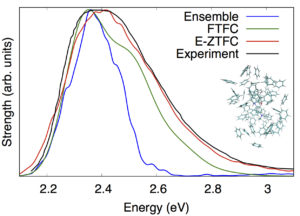 The accurate modeling of optical properties of solvated dyes is challenging, as they often interact with their solvent environment in non-trivial ways, leading to physical phenomena such as solvatochromic shifts of spectra in solvents with different polarities, or changes in the spectral shape. Furthermore, the line shapes of solvated chromophores are often dominated by vibronic effects and the coupling of vibrational motion and electronic excitations has to be carefully accounted for. Our research focuses on the development and testing of computational methods capable of describing spectral line shapes of solvated dyes, by specifically accounting for solvent polarization effects, temperature-dependent broadenings and vibronic couplings. For more information, see: J. Chem. Phys. 148, 024110 (2018); J. Chem. Phys. 151, 074111 (2019)
The accurate modeling of optical properties of solvated dyes is challenging, as they often interact with their solvent environment in non-trivial ways, leading to physical phenomena such as solvatochromic shifts of spectra in solvents with different polarities, or changes in the spectral shape. Furthermore, the line shapes of solvated chromophores are often dominated by vibronic effects and the coupling of vibrational motion and electronic excitations has to be carefully accounted for. Our research focuses on the development and testing of computational methods capable of describing spectral line shapes of solvated dyes, by specifically accounting for solvent polarization effects, temperature-dependent broadenings and vibronic couplings. For more information, see: J. Chem. Phys. 148, 024110 (2018); J. Chem. Phys. 151, 074111 (2019)
Modeling non-linear spectroscopy in complex environments
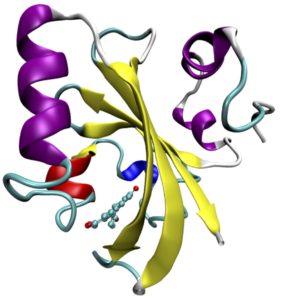 Non-linear optical spectroscopy directly probes the third order response function of a system, giving access to excited state relaxations, vibronic and electronic coherences in complex pigment-protein complexes. 2D electronic spectroscopy (2DES) in particular is a powerful emergent experimental technique, capable of resolving energy transfer dynamics in multi-chromophore pigment-protein complexes on a femtosecond timescale. However, 2DES signals are generally very difficult to interpret, relying heavily on theoretical modeling to identify the physical origin of spectral features.
Non-linear optical spectroscopy directly probes the third order response function of a system, giving access to excited state relaxations, vibronic and electronic coherences in complex pigment-protein complexes. 2D electronic spectroscopy (2DES) in particular is a powerful emergent experimental technique, capable of resolving energy transfer dynamics in multi-chromophore pigment-protein complexes on a femtosecond timescale. However, 2DES signals are generally very difficult to interpret, relying heavily on theoretical modeling to identify the physical origin of spectral features.
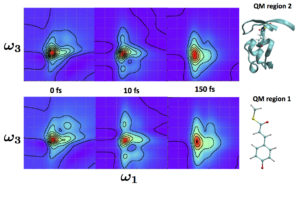 Our research focuses of using ab-initio simulation techniques to model non-linear spectroscopy from first principles, with a special interest in how the complex environment influences spectral features. We show that a full quantum mechanical treatment of large parts of the protein environment surrounding a pigment is necessary to capture signatures of vibronic coherence in the 2D electronic spectra of pigment-protein complexes like the photoactive yellow protein (PYP). For more information, see: J. Phys. Chem. B 124 (3), 531 (2019); J. Chem. Phys. 153, 044127 (2020)
Our research focuses of using ab-initio simulation techniques to model non-linear spectroscopy from first principles, with a special interest in how the complex environment influences spectral features. We show that a full quantum mechanical treatment of large parts of the protein environment surrounding a pigment is necessary to capture signatures of vibronic coherence in the 2D electronic spectra of pigment-protein complexes like the photoactive yellow protein (PYP). For more information, see: J. Phys. Chem. B 124 (3), 531 (2019); J. Chem. Phys. 153, 044127 (2020)
Energy-transport in pigment-protein complexes
Light-harvesting pigment-protein complexes are prominent examples of chromophores embedded in 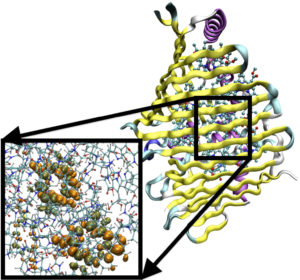 complex environments. In these systems, the same type of pigment is used in a variety of different ways to absorb sunlight and funnel excitons towards the reaction center, and the protein environment plays a key role in fine-tuning the optical properties of individual pigments to allow for efficient energy transfer. First-principles calculations of pigment-protein complexes can be used to parameterize exciton model Hamiltonians that can be used to study the origin of the high efficiency with which light-harvesting systems operate. However, due to the important role played by the protein environment, in influencing the energies of individual pigments and their couplings to each other, a fully quantum mechanical description of large parts of the protein is desirable to fully capture dynamic polarization effects from first principles. Our research interest is in studying the subtle interplay between the pigments and their environment using linear-scaling TDDFT methods.
complex environments. In these systems, the same type of pigment is used in a variety of different ways to absorb sunlight and funnel excitons towards the reaction center, and the protein environment plays a key role in fine-tuning the optical properties of individual pigments to allow for efficient energy transfer. First-principles calculations of pigment-protein complexes can be used to parameterize exciton model Hamiltonians that can be used to study the origin of the high efficiency with which light-harvesting systems operate. However, due to the important role played by the protein environment, in influencing the energies of individual pigments and their couplings to each other, a fully quantum mechanical description of large parts of the protein is desirable to fully capture dynamic polarization effects from first principles. Our research interest is in studying the subtle interplay between the pigments and their environment using linear-scaling TDDFT methods.
Linear-scaling time-dependent density-functional theory
Time-dependent density-functional theory (TDDFT) is a computationally affordable approach to 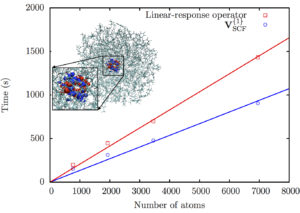 computing excitation energies of molecular and solid state systems. However, conventional implementations of the theory have a computational complexity that scales cubically with the number of electrons in the systems, severely limiting the types of problems that can be studied efficiently.
computing excitation energies of molecular and solid state systems. However, conventional implementations of the theory have a computational complexity that scales cubically with the number of electrons in the systems, severely limiting the types of problems that can be studied efficiently.
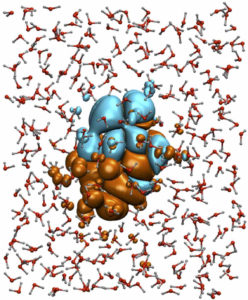 Tim’s past research has been focused on developing linear-scaling approaches to TDDFT by extending known linear-scaling techniques in ground state DFT based on the exponential localization of the single-particle density matrix. The methods are implemented in the linear-scaling DFT code ONETEP, allowing for the calculation of excited states in systems containing thousands of atoms, far beyond the reach of conventional approaches. Using linear-scaling techniques, it is possible to directly model nano-structured materials or chromophores in complex environments, such as solvated dyes and pigment-protein complexes, without having to resort to approximate classical treatments of parts of the system. For further information, see: J. Chem. Phys. 139, 064104 (2013); J. Chem. Phys. 143, 204107 (2015)
Tim’s past research has been focused on developing linear-scaling approaches to TDDFT by extending known linear-scaling techniques in ground state DFT based on the exponential localization of the single-particle density matrix. The methods are implemented in the linear-scaling DFT code ONETEP, allowing for the calculation of excited states in systems containing thousands of atoms, far beyond the reach of conventional approaches. Using linear-scaling techniques, it is possible to directly model nano-structured materials or chromophores in complex environments, such as solvated dyes and pigment-protein complexes, without having to resort to approximate classical treatments of parts of the system. For further information, see: J. Chem. Phys. 139, 064104 (2013); J. Chem. Phys. 143, 204107 (2015)